Your Trusted Home Inspector Philadelphia: Insights for Confident Residential Property Possession
Wiki Article
Emergency Situation Water Damages Remediation: Swift Reaction to Lessen Additional Damages
Water damages can strike suddenly and leave destructive impacts on homes and organizations. When faced with such a scenario, a speedy action is crucial to reduce more damage and protect against potential carcinogen. But just what does emergency situation water damages reconstruction entail? In this discussion, we will certainly look into the value of instant activity, the evaluation procedure, the steps associated with water extraction and drying out, mold and mildew avoidance and removal, and inevitably, the repair of the damaged area. By understanding the necessity and comprehensive nature of this procedure, you will get valuable insights into exactly how experts tackle emergency situation water damages, ensuring a swift and reliable action.Significance of Swift Feedback
Swift action is of utmost significance in water damages repair to decrease more damage and minimize prospective risks. The longer water rests in a building, the even more damages it can trigger.
One of the main factors quick action is crucial in water damage reconstruction is to prevent the growth of mold and mildew and mold. Mold can begin to expand within 24 to two days of water direct exposure, and once it takes hold, it can spread swiftly throughout the damaged location. Mold and mildew not just triggers further damage to the framework of the building but also presents health dangers to owners. By responding quickly, specialists can thoroughly dry out the location and inhibit the development of mold and mildew, lessening the demand for substantial removal and making sure the safety of those included.
Additionally, a prompt reaction can assist salvage and bring back beneficial possessions and ownerships - water damage restoration philadelphia. Water damage can be devastating, especially when it affects personal items of emotional or monetary value. Acting swiftly allows professionals to assess the damages and implement appropriate restoration strategies to recover as high as possible. This not only assists to reduce financial losses but also brings satisfaction to those influenced.
Assessing the Level of Damage

During the evaluation, repair experts completely analyze the damaged location to identify noticeable indicators of damages, such as water stains, warped products, and mold and mildew growth. They likewise use specialized tools to identify surprise damages, such as wetness meters and thermal imaging video cameras. This extensive evaluation permits them to properly identify the extent of the damages and establish a tailored restoration strategy.
Examining the extent of water damages is crucial since it helps specialists prioritize their efforts. They can recognize areas that require instant attention, such as standing water elimination and drying, to avoid additional damage and lessen the risk of mold and mildew growth. They can additionally identify the locations that need fixings or replacement, ensuring that no damages goes neglected or undetected.

Water Extraction and Drying Refine
The water removal and drying out process is an important action in water damages remediation, as it involves the elimination of excess water and the complete drying of the damaged area to stop more damage and mitigate the danger of mold development. After evaluating the level of the water damage, the following step is to remove the water from the afflicted location. This is normally done using customized equipment such as vacuum cleaners, pumps, and dehumidifiers. These devices are designed to effectively and effectively eliminate water from various surfaces, consisting of rugs, wall surfaces, and floors.When the excess water has actually been removed, the drying process starts. This action is vital in preventing second damages, such as architectural damages and the growth of mold and mildew. High-powered fans and dehumidifiers are used to distribute air and eliminate wetness from the air and surface areas. The drying out procedure may take several days, depending on the degree of the water damage and the materials included.
It is crucial to make sure that the damaged location is totally dry before waging any repairs or reconstruction. Failing to extensively dry out the area can lead to long-term concerns, consisting of damaged structures, musty smells, and the development of mold and mildew. Therefore, professional water damages repair business employ dampness discovery devices to ensure that the damaged location is totally dry prior to continuing to the next action.
Mold And Mildew Prevention and Remediation
Effective mold and mildew prevention and removal are essential in water damage restoration to make certain the security and honesty of the afflicted location. mold inspection philadelphia. When water damage happens, whether from a ruptured pipe, flooding, or a dripping roofing system, it develops a suitable environment for mold and mildew development. Mold can begin to develop within 24 to two days after water damages, and if left neglected, it can spread out rapidly and trigger significant health and wellness threatsTo stop mold and mildew development, it is important to resolve water damage quickly. The initial action is to fix the source and determine of the water invasion. As soon as the resource is fixed, the afflicted location needs to be thoroughly dried to stop dampness from sticking around. This may involve making use blog here of dehumidifiers, air moving companies, and various other customized equipment to remove excess wetness from the air and surfaces.
In instances where mold and mildew development has actually currently taken place, removal is essential to remove the mold and mildew and stop its return. This includes the mindful elimination and disposal of affected materials, such as drywall or carpeting, to make sure that all traces of mold and mildew are removed. It is necessary to note that mold remediation ought to be performed by experts who have the required training and equipment to securely get rid of and manage mold.
Restoring the Affected Area

To start with, it is necessary to thoroughly dry the area to stop any type of more damages and to hinder the development of mold and mildew and mold. This might entail the usage of specialized drying out tools, such as dehumidifiers and industrial-grade followers, to get rid of all dampness from the damaged surface areas.
As soon as the location is totally dry, the repair procedure can begin. This may include repairing or replacing damaged structural elements, such as drywall, ceiling, or flooring ceramic tiles. It is very important to deal with any underlying issues that might have created the water damages, such as leaking pipes or faulty pipes, to stop future occurrences.
Furthermore, bring back the affected location might likewise include painting walls, replacing harmed components, and thoroughly cleaning and sanitizing the room. This makes sure that not only is the area structurally audio, however it is also cosmetically pleasing and risk-free for occupancy.
Verdict
In final thought, swift response is critical in lessening further damages triggered by water emergencies. Analyzing the degree of damages enables effective water removal and drying procedures to be implemented. In addition, mold avoidance and remediation are crucial in bring back the affected location. Overall, prompt activity and complete restoration procedures are key to alleviating the negative effects of water damages.Swift feedback is of utmost importance in water damage repair to minimize additional damages and minimize potential risks.During the analysis, reconstruction professionals completely take a look at the Get the facts damaged location to identify visible indications of damage, such as water spots, deformed products, and mold and mildew growth.The water extraction and drying process is a crucial step in water damage remediation, as it includes the elimination of excess water and the detailed drying out of the damaged location to prevent further damage and reduce the danger of mold growth. After examining the level of the water damages, the following action is to draw out the water from the afflicted area.Efficient mold prevention and remediation are essential in water damage remediation to guarantee the safety and integrity of the affected location.
Report this wiki page